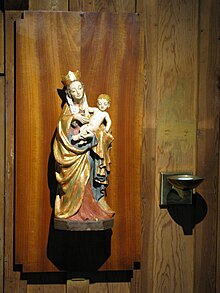St. Joseph (Lindow (Mark))

The Roman Catholic Church of St. Joseph in Lindow (Mark) was built in 1931 according to the designs of the Berlin architect Wilhelm Fahlbusch and is a listed building .
history
In 1926, the Catholic Kapellenbauverein bought a building plot on a hill east of the Lindow town center and obtained financial aid for the construction of the church. The day of the laying of the foundation stone was June 7th, 1931, the consecration took place on September 22nd, 1931. Together with the Cistercian convent founded around 1230 and the baroque Protestant town church (built 1751–1755 according to plans by Georg Christoph Berger), the church forms a triad that is important in terms of town history and town planning. Since 2014, the St. Joseph Church has been inhabited and run as a hermitage under the name St. Bernhard by a priest as a hermit . The hermitage is named after Bernhard von Clairvaux , co-founder of the Cistercian Order, which means that the name is to be understood as a continuation of the monastic tradition in Lindow. Around the church, simple wooden houses offer guest accommodation for retreats and individual retreats .
architecture
The church was built in massive construction from unplastered reddish-brown clinker bricks - burned in the neighboring Seebeck - and regionally felled wood by Lindow craftsmen in a short construction period. The building, which is oriented in an east-west direction, consists of an annex , the nave and a wide rectangular church tower, and its proportions refer to medieval Brandenburg village churches. Nevertheless, this church building is to be seen as a work of factual, functional architecture of the new building that is seldom found in the region . The church is accessed from Pestalozziweg and from the street Am Wutzsee and is surrounded by wooded property. While the church of St. Joseph was in a free position above the city at the time of its construction, it is now strongly delimited from the east and south by the addition of immediately adjacent communal buildings and open spaces.
Church interior
A stepped plinth leads to a simple church room, the main accent of which is set by an artistically significant life-size figure of Joseph made of linden wood by the sculptor Harriet Ellen Siderovna von Rathlef-Keilmann (1887–1933). Opposite her is a statue of Mary as a linden wood replica of the “Beautiful Mother of God” from Wroclaw from 1390.
Peal
According to a list of delivery bell foundry Otto from Hemelingen / Bremen for the years 1930-1932 and poured gasoline supplied for the St. Joseph's church two bronze - bells , tuned to gis and h. The larger bell was dedicated to St. Joseph and the smaller bell to Mary, the Mother of God. While the Joseph Bell was removed and melted down for armaments purposes on March 19, 1942, the hand-rung St. Mary's Bell was preserved.
swell
- Chronicle Issues, No. 5 (November 2001)
- Expert opinion on the monument value. Brandenburg State Office for Monument Preservation, December 2002.
Web links
Individual evidence
- ^ Gerhard Reinhold: Otto bells. Family and company history of the Otto bell foundry dynasty . Self-published, Essen 2019, ISBN 978-3-00-063109-2 , p. 588, especially page 534 .
- ↑ Gerhard Reinhold: Church bells - Christian world cultural heritage, illustrated using the example of the bell founder Otto, Hemelingen / Bremen . Nijmegen / NL 2019, p. 556, especially p. 494 , urn : nbn: nl: ui: 22-2066 / 204770 (dissertation at Radboud Universiteit Nijmegen).
Coordinates: 52 ° 58 ′ 8.9 ″ N , 12 ° 59 ′ 35.5 ″ E



